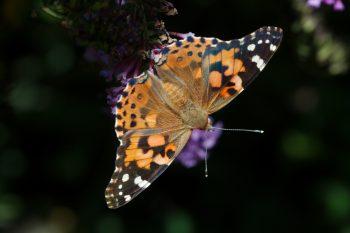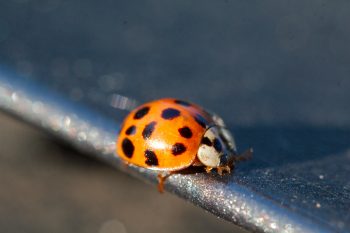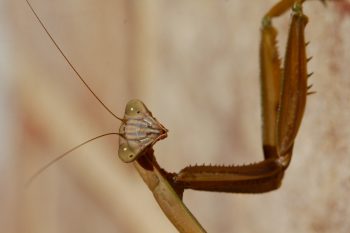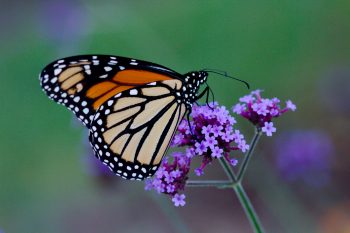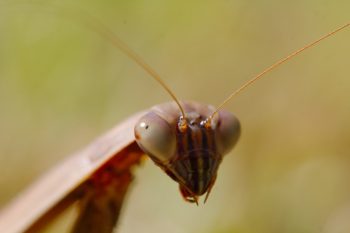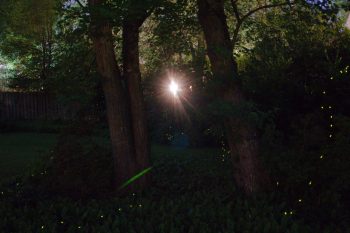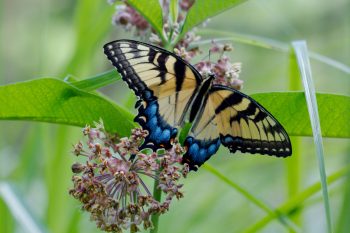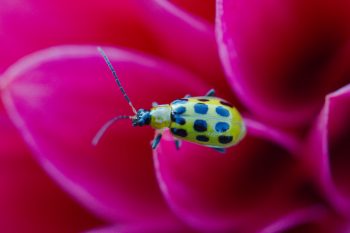I’m not at all sure what this wasp is but I’m going to guess it’s a Polistes species, possibly P. fuscatus, the northern paper wasp. I like this head-on shot, although I’d like to have a bit more depth of field. The wasps and bees were thick in the mountain mint and buddleia this afternoon. Autumn is arriving, though, and it’s been cooler, so the insects are not quite so nemerous except in the heat of mid-day. I also got a few pictures of a beewolf (Philanthus gibbosus).
Tagged With: Insect
Paper Wasp (Polistes Sp.)
Monarch Wing
Underneath one of the buddleias in our back garden I found the remains of a monarch butterfly (Danaus plexippus). Just last Friday I had photos of a monarch caterpillar (see Friday, September 11). This is the other end of the life cycle, the death of an adult butterfly. Monarchs are quite widespread, being found throughout much of North and South America (and apparently have been introduced in Australia). The color on the wings of a butterfly are made up of very small scales. In the full size version of this image, they are visible, especially in the orange areas.
Honey Bee on Aster
Cathy and I took a walk along Croyden Creek early this afternoon. It has turned cool, although with the humidity in the woods and the steep nature of the trail, I was fairly warm. It was nice to get out, of course, and we only saw a few other people. We walked from the Croyden Creek Nature Center down stream almost to where it joins Rock Creek. Coming back, we turned up a side valley and came out between the two main parts of Rockville Cemetery. Back and the nature center, I took this photo of a western honey bee (Apis mellifera) on an aster of some sort.
Vanessa cardui (Painted Lady)
I’ve posted photos of painted lady butterflies (Vanessa cardui) before, but not this year. Each of the others show the underside of the wings, which are often folded up when the butterfly is on a flower. I spent quite a while following this one around and managed to get a pretty good shot of the upper wing surface. It’s a pretty, mid-sized butterfly that’s found in five of the seven continents (all but South America and Antarctica). This is the first I’ve seen this year, so I was excited to be able to get some good pictures.
Harmonia axyridis (Asian Lady Beetle)
I went out this morning to bring the recycle bins back from the curb and happened to notice this little Asian lady beetle (Harmonia axyridis) on the hood of my car. So, it’s not a terribly natural setting and I’ve have loved to be able to photograph it on a flower or something, but I’m keeping it real and telling it like it is (or was). These are quite common in our area and can be found pretty much throughout the United States and southern Canada. They are native to eastern Asia from the Altai Mountains to the east coast and Japan. Their spot pattern and colors are extremely variable, including the black spots on an orange base, as seen here, but also black on red, red, orange, or yellow on black, and even solid with no spots.
Vanessa atalanta (Red Admiral)
This is the first red admiral (Vanessa atalanta) I’ve seen in the yard this year. It’s wings are pretty ragged but it was fluttering around well enough. We’re seeing fewer butterflies lately, now that it’s cooled off so much, but once in a while we get a treat like this. This one is resting on a rose trellis on the end of our house that used to have a huge, climbing rose on it. That rose died to the ground a while back but it’s finally starting to get up onto the trellis again. Hopefully in a few more years it will be back to its former glory.
The red admiral is cousin to the painted lady (Vanessa cardui) whose picture I posted just over a week ago.
Monarch Butterfly (Danaus plexippus)
The late afternoon sun was shining on the hawthorn berries and I took some pictures of them before spotting this monarch butterfly (Danaus plexippus) flitting around the tall verbena (Verbena bonariensis). She flew off for a while but I waited and she came back and I was able to get some pretty nice photos. I figured I can get pictures of the hawthorn again tomorrow. The butterflies are getting to be fewer and fewer, so I want to capture them while I can. We’ve had a pretty steady presence of monarchs this summer, although rarely more than one at a time. This one is in particularly fine shape.
Junonia coenia (Common Buckeye)
Just a few days ago I mentioned that we were seeing fewer butterflies in the garden. Then I saw and photographed a painted lady (Vanessa cardui), a red admiral (Vanessa atalanta), a monarch (Danaus plexippus), and today a common buckeye (Junonia coenia), all within just over two weeks. So, the summer is going out strong in terms of butterflies. The common buckeye is not particularly rare here, but we haven’t seen a lot of them this year. It’s a pretty butterfly and quite distinctively marked. Like the recently photographed painted lady and monarch, this one is on the Verbena bonariensis.
Lightning Bugs (a.k.a. Fireflies)
I’m not sure how well this will show up unless it’s viewed on a largish screen. Anyway, I decided to try taking long exposures to capture the flashing lights of lightning bugs, otherwise known as fireflies. They didn’t turn out as well as I would have liked, because when I used a long enough exposure to get a lot of flashes, parts of the picture were so bright that it looked like day time. That was mostly due to electric lights from our neighbors. If I get a chance, I may try to find a darker spot and see what I can do. The trails of lights are generally made by individual insects, flying along flashing as they go.
Tiger Swallowtail on Milkweed
I stopped at the Croyden Creak Nature Center again this afternoon. I took a picture of Joe Pye weed here two weeks ago (see Wednesday, June 16, 2021) and wanted to see if it had started to bloom. It really hadn’t but it’s getting close. I walked around and took a few pictures, anyway, including a few of this eastern tiger swallowtail butterfly (Papilio glaucus) enjoying the swamp milkweed (Asclepias incarnata). There was also a nice buttonbush (Cephalanthus occidentalis) in bloom. It has spherical clusters of tiny flowers that like little pincushions.
Diabrotica undecimpunctata (Spotted Cucumber Beetle)
Cathy’s brother arrived from the Chicago area today and in the evening we all went to the Agricultural Farm Park. In the dahlia garden, we spotted this spotted cucumber beetle (Diabrotica undecimpunctata) on a beautiful magenta dahlia. It’s not peak season for the dahlias quite yet, but there are enough blooms to make it worth visiting, if you’re in the area. The demonstration garden ‘next door’ is in fine fettle and also worth walking through. It’s in a lot better shape this summer than last year, when I suspect getting people to work on it was a bit harder.




